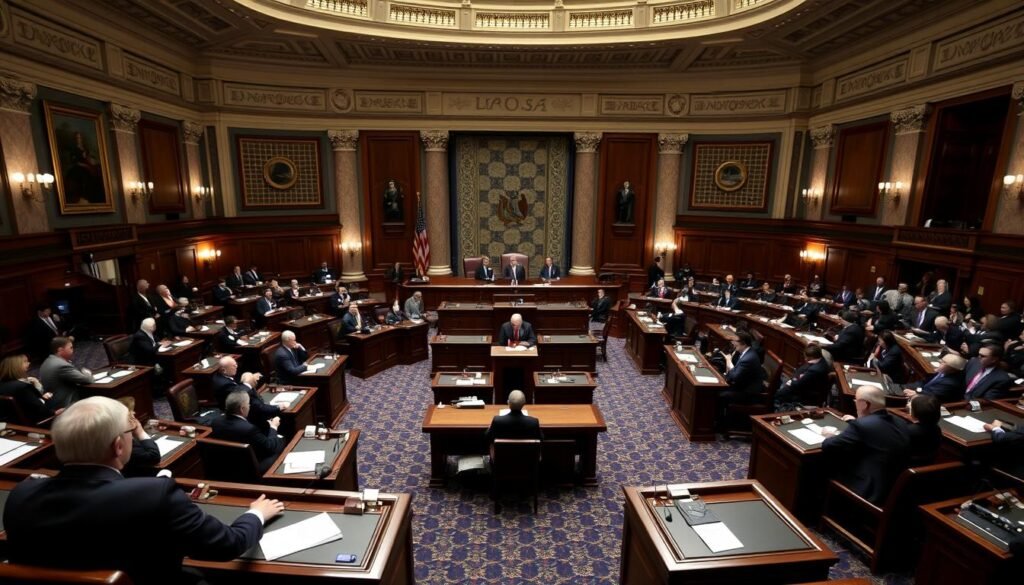President Trump’s “One Big Beautiful Bill” represents one of the most significant tax overhauls in recent American history. For middle-class families navigating an increasingly complex financial landscape, understanding these changes is crucial for household budgeting, retirement planning, and financial security. This comprehensive analysis breaks down how the Trump tax simplification measures could impact your family’s bottom line, comparing it with previous administrations’ approaches and offering expert insights on its long-term implications.
Key Provisions of Trump’s Tax Simplification
The centerpiece of Trump’s tax agenda, officially titled the “One Big Beautiful Bill,” makes permanent several provisions from the 2017 Tax Cuts and Jobs Act (TCJA) that were set to expire after 2025. According to the Congressional Budget Office, the legislation would increase the federal deficit by approximately $3.4 trillion over the next decade, a figure that has sparked intense debate among economists and policymakers.
“This legislation represents the most significant tax simplification effort since the Reagan administration. However, simplification doesn’t necessarily mean equal benefits across income levels,” notes Howard Gleckman, senior fellow at the Urban-Brookings Tax Policy Center.
For middle-class families, several provisions stand out as particularly impactful:
Extended Tax Brackets
The bill permanently extends the TCJA’s seven tax brackets (10%, 12%, 22%, 24%, 32%, 35%, and 37%), preventing a reversion to higher pre-2017 rates. For a family earning $75,000 annually, this represents approximately $1,000 in tax savings compared to pre-TCJA rates, according to Tax Policy Center analysis.
Expanded Standard Deduction
The standard deduction increases from $15,000 to $16,000 for single filers and from $30,000 to $32,000 for joint filers for tax years 2026-2028. IRS data shows that 87% of taxpayers now take the standard deduction, up from 68% before the TCJA.
Direct Impact on Middle-Class Family Finances
For middle-class families (those earning between $50,000 and $200,000 annually), the tax changes create a mixed picture of benefits and potential concerns. The Tax Policy Center estimates that households in this income range would see their after-tax income increase by approximately 1.5% to 2.5%.
| Income Range | Average Tax Cut (2026) | % Increase in After-Tax Income | % of Total Tax Benefits |
| $40,000-$50,000 | $630 | 1.5% | 4.2% |
| $50,000-$75,000 | $1,000 | 1.9% | 7.8% |
| $75,000-$100,000 | $1,700 | 2.3% | 9.3% |
| $100,000-$200,000 | $3,000 | 2.5% | 18.7% |
However, William Gale of the Brookings Institution cautions that these benefits may not be evenly distributed: “While the tax cuts provide some relief to middle-class families, the legislation disproportionately benefits higher-income households. Nearly 60% of the tax benefits go to those in the top quintile of annual incomes.”
New Tax Relief Measures
Tax-Free Tips
The bill exempts qualified tips from federal income tax up to $25,000, providing significant relief for service industry workers. For a waitress earning $30,000 annually with $15,000 in tips, this could mean tax savings of approximately $1,800.
Senior Deduction
A new $6,000 deduction for Americans over 65 will last through 2028, potentially saving seniors in the 22% tax bracket about $1,320 annually, according to calculations based on IRS data.
Overtime Tax Relief
A $12,500 deduction aimed at reducing taxes on overtime could benefit approximately 18.5 million workers who regularly work overtime hours, based on Bureau of Labor Statistics data.
SALT Cap Changes and Their Significance
One of the most debated aspects of the Trump tax simplification is the adjustment to the State and Local Tax (SALT) deduction cap. The bill increases the SALT cap from $10,000 to $40,000 for joint filers, with a gradual phase-down for those earning over $500,000.
“The SALT cap increase primarily benefits upper-middle-class homeowners in high-tax states like New York, California, and New Jersey. For a family in these states with $20,000 in property taxes and $15,000 in state income taxes, this change could mean thousands in additional deductions.”
Census Bureau data shows that the median property tax in high-tax counties exceeds $10,000, meaning many middle-class homeowners in these areas were previously unable to deduct their full property tax burden. The new cap addresses this issue, though critics argue it primarily benefits wealthier households.
SALT Cap Timeline: The $40,000 cap will be in place from 2025-2029, indexed for inflation, before reverting to $10,000 in 2030. This temporary nature creates a planning opportunity for taxpayers in high-tax states.
Historical Comparison: Trump vs. Previous Tax Reforms
To understand the significance of Trump’s tax simplification, it’s helpful to compare it with previous major tax reforms. The approach differs markedly from both Republican and Democratic predecessors.
| Administration | Key Tax Legislation | Approach to Brackets | Middle-Class Impact |
| Reagan (1986) | Tax Reform Act | Reduced from 15 brackets to 2 | Average 8% tax reduction, eliminated many deductions |
| Bush (2001/2003) | EGTRRA/JGTRRA | Reduced rates across all brackets | Child tax credit doubled, marriage penalty reduced |
| Obama (2012) | American Taxpayer Relief Act | Extended Bush tax cuts for incomes under $400,000 | Permanent AMT fix, payroll tax holiday |
| Trump (2017/2025) | TCJA/One Big Beautiful Bill | Maintained 7 brackets with lower rates | Doubled standard deduction, expanded child tax credit |
Unlike Reagan’s dramatic simplification that reduced the number of tax brackets, Trump’s approach maintains the existing seven-bracket structure while lowering rates. And unlike Obama’s targeted approach that focused relief on incomes below $400,000, Trump’s plan provides cuts across income levels, though with larger percentage benefits for higher earners.
Legislative Context and Political Dynamics
The passage of Trump’s tax simplification bill reflects the complex political dynamics surrounding tax policy in America. The bill passed with a narrow margin in the House (218-214) and required Vice President JD Vance’s tie-breaking vote in the Senate.
Republican Support
Senator Rick Scott (R-FL), a key supporter of the legislation, argued: “This bill delivers on our promise to make the tax code simpler and fairer for hardworking Americans. By making these tax cuts permanent, we’re providing certainty that families and businesses need for long-term planning.”
House Republicans emphasized the bill’s focus on economic growth, with Ways and Means Committee Chairman Jason Smith stating that the permanent tax cuts would “unleash American innovation and job creation.”
Democratic Opposition
Senator Elizabeth Warren (D-MA) criticized the bill during a floor speech, stating: “This isn’t tax simplification—it’s a $3.4 trillion giveaway that primarily benefits corporations and the wealthy while doing little for working families. Meanwhile, it creates a massive hole in our budget that will inevitably lead to cuts in critical programs.”
House Democrats unanimously opposed the bill, with many citing concerns about its impact on the deficit and its failure to address what they view as corporate tax loopholes.
Offset Provisions: The Other Side of Simplification
While much attention focuses on the tax cuts, the bill also includes significant spending reductions and program changes designed to partially offset the cost of tax relief. These measures have sparked controversy and could affect many middle-class families who benefit from the programs being cut.
Tax Relief Provisions
- Permanent extension of lower tax brackets
- Increased standard deduction ($16,000 single/$32,000 joint)
- Child tax credit increase to $2,200 per child
- SALT cap increase to $40,000 (through 2029)
- Tax exemption for tips up to $25,000
- $6,000 deduction for seniors (through 2028)
Offset Provisions
- $1 trillion reduction in Medicaid spending
- New work requirements for SNAP benefits
- Elimination of clean energy tax credits
- Stricter eligibility verification for ACA subsidies
- Removal of limitation on ACA premium tax credit recapture
- Elimination of federal funding for Planned Parenthood
The Congressional Budget Office estimates that approximately 12 million low-income Americans could lose health insurance coverage by 2034 due to Medicaid changes, while the Urban Institute projects that expanded SNAP work requirements could cut 5.4 million people from monthly food benefits.
“The bill’s offset provisions create a concerning situation where tax relief for middle and upper-income households is partially funded by reducing support for lower-income families. This raises serious questions about the overall progressivity of the tax system.”
Real-World Impact: A Florida Family Case Study
To illustrate the practical effects of Trump’s tax simplification, consider the Martinez family from Tampa, Florida—a middle-class household with two children and a combined income of $85,000.
The Martinez Family: Before and After
Michael and Sofia Martinez own a modest 3-bedroom home and have two children, ages 8 and 12. Michael works as a construction supervisor ($55,000) while Sofia is a part-time nurse who also earns tips as a weekend server ($30,000, including $12,000 in tips).
2023 Tax Return (Under TCJA)
- Standard Deduction: $27,700
- Child Tax Credits: $4,000 ($2,000 per child)
- Effective Tax Rate: 9.8%
- Federal Tax Bill: $8,330
Projected 2026 Return (Under New Law)
- Standard Deduction: $32,000 (+$4,300)
- Child Tax Credits: $4,400 (+$400)
- Tax-Free Tips: $12,000 reduction in taxable income
- Effective Tax Rate: 7.2%
- Federal Tax Bill: $6,120
- Annual Savings: $2,210
For the Martinez family, the combination of the increased standard deduction, expanded child tax credit, and the tax exemption for tips creates meaningful savings. However, if Sofia’s employer-provided health insurance premiums increase due to healthcare market changes resulting from Medicaid cuts, some of these gains could be offset.
Expert Analysis: Beyond the Numbers
Tax policy experts offer varying perspectives on the long-term implications of Trump’s tax simplification measures. While there’s general agreement that most taxpayers will see some benefit in the short term, opinions differ on the sustainability and fairness of the approach.
Economic Growth Perspective
Proponents argue that making the tax cuts permanent will stimulate economic growth by providing certainty for businesses and consumers. The Tax Foundation estimates that the permanent extension of TCJA provisions could increase GDP by 0.4% over the next decade.
“By providing certainty in the tax code, this legislation allows businesses to make long-term investments and families to plan their finances with confidence,” notes Douglas Holtz-Eakin, former Congressional Budget Office director.
Fiscal Sustainability Concerns
Critics point to the significant impact on the federal deficit. The Committee for a Responsible Federal Budget estimates the bill would add $4.1 trillion to the national debt over ten years, potentially leading to higher interest rates and reduced fiscal flexibility.
“This approach to tax policy prioritizes short-term relief over long-term fiscal health,” argues Maya MacGuineas, president of the Committee for a Responsible Federal Budget.
“The real test of tax simplification isn’t just whether it reduces rates or paperwork—it’s whether it creates a system that’s both efficient and equitable. The current approach achieves some simplification goals but raises serious questions about vertical equity across income levels.”
Tax Planning Strategies for Middle-Class Families
With the new tax landscape taking shape, middle-class families can adopt several strategies to maximize benefits and minimize potential downsides:
Short-Term Planning
- Adjust withholding to reflect expected tax savings
- Maximize contributions to tax-advantaged accounts (401(k), HSA)
- For service workers, track tips carefully to maximize the new exemption
- Seniors should document eligibility for the new $6,000 deduction
Medium-Term Planning
- Consider accelerating property tax payments while SALT cap is higher
- Plan major purchases to maximize available deductions
- Review healthcare coverage options as ACA changes take effect
- Evaluate timing of retirement account withdrawals for seniors
Long-Term Planning
- Prepare for potential 2030 SALT cap reduction
- Consider estate planning implications of higher exemption thresholds
- Develop contingency plans for potential future tax changes
- Diversify retirement accounts between traditional and Roth options
Need Help Navigating the New Tax Landscape?
Tax laws are complex, and personalized advice can help you maximize benefits while avoiding pitfalls. Our network of qualified financial advisors can provide guidance tailored to your specific situation.
Conclusion: Simplification or Redistribution?
Trump’s tax simplification measures offer tangible benefits for many middle-class families through lower rates, higher standard deductions, and targeted relief for specific groups like service workers and seniors. For a typical family earning $75,000-$100,000, the annual tax savings of $1,700 represents meaningful relief that can help with rising costs of housing, education, and healthcare.
However, the legislation’s broader impacts—including significant deficit increases and cuts to social programs—raise important questions about its long-term sustainability and distributional effects. The Institute on Taxation and Economic Policy projects that the poorest 20% of Americans would get just 1% of the total tax cuts in 2026, while the richest 20% would receive 68%.
As families navigate this changing tax landscape, the key question remains: Will tax simplification bridge the gap or widen inequality? The answer likely depends not just on the direct tax benefits received, but also on how the broader economic and social impacts of the legislation affect household financial security over time.
When do these tax changes take effect?
Most provisions take effect for the 2026 tax year (filed in 2027), though some changes like the SALT cap increase begin in 2025. The senior deduction and tax-free tips provision are available through 2028.
How can I calculate my specific tax savings?
While general estimates are helpful, your specific situation may vary based on income sources, deductions, and credits. A tax professional can provide personalized analysis, or you can use online tax calculators that have been updated with the new provisions.
What happens after temporary provisions expire?
Several provisions, including the increased SALT cap and senior deduction, are temporary and set to expire after 2028-2029. Congress may extend these provisions in the future, but families should plan for potential changes when these sunset dates approach.
Stay Informed About Tax Changes
Tax laws continue to evolve. Subscribe to our newsletter for updates on tax policy changes and strategies to optimize your family’s financial position.





